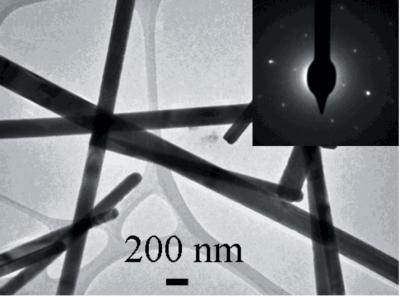Nanosheets and nanowires

This is a typical TEM image of as-prepared GeS nanowires with the inset showing a selected area electron diffraction pattern taken from GeS nanowires. Credit: Liang Shi and Yumei Dai
Germanium monosulfide, GeS, is emerging as one of the most important “IV–VI” semiconductor materials with potential in opto-electronics applications for telecommunications and computing, and as an absorber of light for use in solar energy conversion.
One important property is its much lower toxicity and environmental impact when compared to other semiconductors made with cadmium, lead and mercury.
It is less costly than other materials made with rare and noble metal elements. Indeed, glassy GeS has been used in lasers, fibre optic devices and infrared lenses as well as rewritable optical discs and non-volatile memory devices for several years. It is also used extensively as a solid electrolyte in conductive bridging random access memory (RAM) devices.
The repertoire of this material might be extended much further with the extra control that its use as nanostructured systems might allow. Liang Shi and Yumei Dai of the University of Science and Technology of China, in Hefei, point out that research in this area has lagged behind that with other IV-VI semiconductors.
They hope to change that and have focused on how nanosheets and nanowires of GeS might be readily formed. They have used X-ray powder diffraction, transmission electron microscopy, energy-dispersive X-ray spectrometry and scanning electron microscopy to investigate the structure, morphology, composition and optical absorption properties of their samples.
The team used simple “wet” chemistry to synthesis their products using germanium dichloride-dioxane complex, thiourea and oleylamine (OLA) as starting materials. The ingredients were mixed in a sealed reaction flask, blasted with ultrasound to exclude air and then stirred and heated.
The team was able to make nanosheets of GeS this way if the process was carried out for several hours at 593 Kelvin. At higher temperature, 613 Kelvin, they found that the sheets wind up into nanowires. Indeed, the precise heating time and temperature allowed them to control the structure of the final product. The team suggests that the rolling up of the nanosheets into nanowires is driven by the surface tension between the sheet and the OLA molecules during the heating.
Having proven the structural integrity of their GeS nanowires and nanosheets, the team built several test devices – a photoresponsive unit – which they used to evaluate the optical and electronic properties of the products. The team says that they have demonstrated “outstanding photoresponsive behaviour”. This “indicates the potential use of as-synthesized GeS nanosheets and nanowires in solar energy conversion systems, such as the fabrication of photovoltaic devices”.
For more information please contact
Dr Jonathan Agbenyega
Business Development Manager, IUCr
00 +44 (0) 1244 342878
ja@iucr.org
About the IUCr
The IUCr is a scientific union adhering to the International Council for Science (ICSU). Its objectives are to promote international cooperation in crystallography and to contribute to all aspects of crystallography, to promote international publication of crystallographic research, to facilitate standardization of methods, units, nomenclatures and symbols, and to form a focus for the relations of crystallography to other sciences.
The IUCr fulfils these objectives by publishing in print and electronically primary scientific journals through Crystallography Journals Online, the series of reference volumes International Tables for Crystallography, distributing the quarterly IUCr Newsletter, maintaining the online World Directory/Database of Crystallographers, awarding the Ewald Prize and organising the triennial Congress and General Assembly.
Media Contact
More Information:
http://www.iucr.orgAll latest news from the category: Physics and Astronomy
This area deals with the fundamental laws and building blocks of nature and how they interact, the properties and the behavior of matter, and research into space and time and their structures.
innovations-report provides in-depth reports and articles on subjects such as astrophysics, laser technologies, nuclear, quantum, particle and solid-state physics, nanotechnologies, planetary research and findings (Mars, Venus) and developments related to the Hubble Telescope.
Newest articles

Combatting disruptive ‘noise’ in quantum communication
In a significant milestone for quantum communication technology, an experiment has demonstrated how networks can be leveraged to combat disruptive ‘noise’ in quantum communications. The international effort led by researchers…

Stretchable quantum dot display
Intrinsically stretchable quantum dot-based light-emitting diodes achieved record-breaking performance. A team of South Korean scientists led by Professor KIM Dae-Hyeong of the Center for Nanoparticle Research within the Institute for…

Internet can achieve quantum speed with light saved as sound
Researchers at the University of Copenhagen’s Niels Bohr Institute have developed a new way to create quantum memory: A small drum can store data sent with light in its sonic…





















